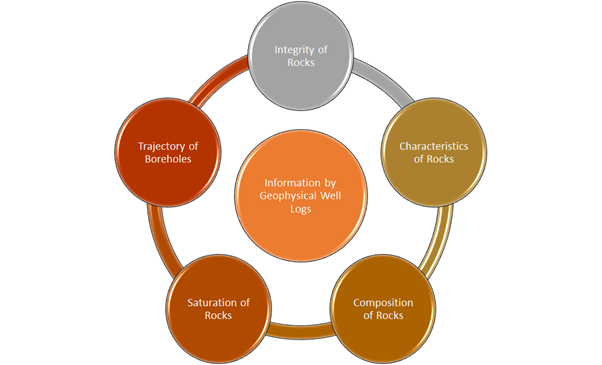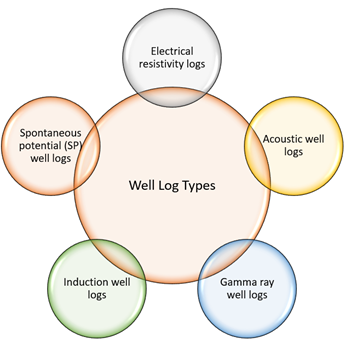Well Logging is a technique to collect data from the borehole to determine subsurface formations' physical properties. Also known as wireline logging, it is an indirect method of evaluation, as there is no direct contact with the formations. The technique allows us to determine the reservoir properties of rocks present beneath the surface of the Earth. Well logging is a key technique used in the exploration of minerals and O&G.
Understanding Well Logging in Detail:
A well log is typically a record of the formations or events that are encountered during drilling. Sometimes it is also referred to as borehole logging.
Well logs are recognised as legal papers, which captures the activities - a well from the drilling stages to its completion.
A well log can be prepared by two different processes, i.e. by visual inspection of drill cuttings or specially-designed logging equipment, which can be lowered into the borehole to record various events.
The well log, which is prepared by the visual inspection of rock chip samples, is known as Geological Log, whereas the log prepared by using logging units is known as geophysical well logs.
The technique is primarily used for the evaluation of geological formation. The evaluation has wide applications in groundwater, hydrocarbon, and mineral exploration.
Process of Geophysical Well Logging:
During the geophysical well logging, the logging tool is inserted into the borehole with the help of a wireline. A typical logging tool consists of a transmitter and a receiver, which is used to transmit and receive the signals.
Depending on the type of logging tool, relevant energy is transmitted to the formation by the transmitter. Upon reflection from the formation, the energy is recorded back at the receiver of the tool. The reflected energy carries useful information about the formation with them. It must be noted that this is an indirect technique of formation evaluation, which means the technique doesn't record any physical property of the formation on a direct measure basis.
The information collected at the receiver is then transmitted to the surface with cables, which can be decoded in software for further interpretation by geologists and petrophysicists.
What information does logging tools bring?
The logging tools are designed to bring the various type of information required for formation evaluation by geoscientists. This may range from physical to chemical and structural information about the subsurface formations. Some of the major information that can be revealed from the well logging techniques are:

Copyright © 2021 Kalkine Media Pty Ltd
Characteristics of Rock: It means one can determine the porosity, permeability, and saturation of rocks, to evaluate the volumetric space, where the hydrocarbons or minerals are accumulated.
Composition of Rocks: It means geologists can determine the type of rock present at a specific depth. Either, it's shale, sandstone or limestone.
Saturation: The petrophysicists can find the amount of saturation, which means the void space volume that is accommodated by liquids.
The trajectory of the Borehole: The technique can also tell us about the size, shape and trajectory of the borehole.
The integrity of Rocks: In addition to all the above advantages, the technique is well versed to identify cavings and other structural weaknesses along the wall of the borehole, which may lead to various potential borehole problems.
History of Well Logs:
Conrad Schlumberger first started the science of well logging in 1927 as part of his work related to the Earth's resistivity measurements for surface exploration. Later on, the advancement in technology and more precise results made the technology more popular. The demand rose rapidly internationally.
Types of Well Logs
Various types of well logs can be recorded with the help of logging tools, depending on the scope of requirement. There is a huge list of types of well logs that are used in the industry today. We will briefly discuss some most prominent logs, which are frequently used in the industry by experts.

Copyright © 2021 Kalkine Media Pty Ltd
- Electrical resistivity: Electrical logs are formed by passing current into the formation and recording the formation's resistance to pass the current to the receiver end. This log provides a good indication of the type of formation fluid present in rocks' pore space. The water present in pore spaces is freshwater, or saline water, since saltwater conducts electric current more easily than freshwater.
- Acoustic: Acoustic logs are also used to see the saturation level of pore spaces present in the rock formations. In this technique, a sound wave is transmitted into the formation and recorded back into the receiver. The easiness of sound waves to travel in fluid-bearing formation tells us about the formation's saturation content.
- Gamma ray: Gamma logs are used to determine the shale content present in the formation. Clay present in the formation emits gamma rays, which are measured by the tool, indicating the type of formation. It basically discriminates between shale and non-shale formations.
- Induction: Induction logs are used in wells where simple electric logs can't be run due to the presence of air or oil. Induction logs use the induction technique to determine the resistivity.
- Spontaneous potential (SP): SP log is used to determine the permeability and porosity of the formation.
Applications of Well Logging:
Well Logging has a wide range of applications from mining to oil and gas exploration. The technique is also used for groundwater exploration. The method has majorly following applications:
- Well logs are used to determine Facies and Depositional Environment
- Lithofacies Analysis using well log data and seismic sections.
- Well log can provide quantitative richness of organic-rich formations, which can be used to determine Organic Carbon and Source Rocks.
- The technique is also used to determine Abnormal Pressure Detection and Evaluation in drilling to avoid unwanted kicks.
- Exploration of Coalbed Methane, Shale Oil, Heavy Oil, Shale Gas, Coal and Tar Sands.
- Logging can also be used to determine the strength and quality of cementing done at the time of casing a well.
- Mineral Extraction and Evaluation.
- Ground Water Applications.
 Please wait processing your request...
Please wait processing your request...